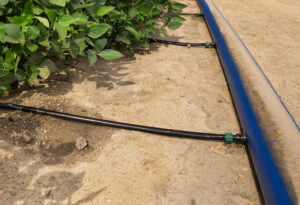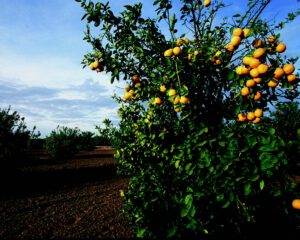N‑Drip wants to help solve the global water crisis by helping the world’s farmers convert flood irrigation to gravity-powered microirrigation. Its system, developed by Israel’s former water commissioner, Professor Uri Shani, transforms existing flood infrastructure into cost-effective, precise drip systems, without the use of filters or pumps. Irrigation Leader spoke with N‑Drip’s U.S. vice president for business development, Uri Segev, about how N‑Drip is helping farmers become more efficient so that they can increase yields with much less input, one field at a time.
Irrigation Leader: Please tell us about your background and how you came to be in your current position.
Uri Segev: I’m originally from Israel. I was born and raised on a kibbutz in a small farming community and grew up among cotton and cornfields. To conserve water in Israel’s desert and semiarid climate, flood irrigation had already been forbidden, so I got to see efficient drip irrigation at work. When I relocated to the United States in the mid- 1990s, I changed direction from farming to real estate finance. Then, 3½ years ago, I got the opportunity to join N‑Drip as vice president for business development in the United States.
Irrigation Leader: Where is N‑Drip headquartered in the United States?

Uri Segev: We are in Phoenix, Arizona. We made a strategic decision a little over a year ago to move our headquarters from California to focus on the Arizona market.
Irrigation Leader: What are your current projects in Arizona?
Uri Segev: We are currently working in two areas. In Yuma, Arizona, we are converting thousands of acres of citrus fields from flood irrigation to our N‑Drip system. We are also converting alfalfa fields along the Colorado River. Within the next few months, we plan to open another strategic location in Casa Grande to service the Pinal Feeding Company, one of the largest cattle feeding operations in the Southwest.
Irrigation Leader: How is N‑Drip different from traditional drip irrigation?
Uri Segev: N‑Drip is the first microirrigation system powered by gravity alone. It transforms existing flood infrastructure and topography into high-efficiency microirrigation without the use of filters or pumps. Depending on the type of crop and the season, the system can save 40–60 percent of the water used in flood irrigation. N‑Drip works with close to zero pressure, requiring only 0.87 pounds per square inch to generate the power needed to run water throughout the fields. Since most irrigation infrastructure in Arizona is currently flood, we can simply tap into existing irrigation canals with a simple PVC pipe connection. When the water reaches the field, it enters our system, which runs with unfiltered water throughout.
Irrigation Leader: Does N‑Drip use emitters, like a traditional drip system?
Uri Segev: Yes and no. The N‑Drip system does incorporate an emitter to enable efficient irrigation, but unlike other drip systems, our proprietary model is based on a concept that works without the need for high-pressure energy and filters. Eliminating the conventional zigzag mechanism of a conventional dripper, we have created a multidimensional flow from the inlet to the outlet, which is highly resistant to clogging caused by brackish water and sand particles. The emitter is manufactured on our production line and is embedded directly into the dripline tape. The driplines are then installed in the field. We have patented both the emitter and the algorithm we use to plan the field design.

Irrigation Leader: Would you describe the tape and how it is installed?
Uri Segev: The installation of N‑Drip is simple. Our 44‑millimeter (1.73‑inch) tape comes on a spool that is around 600 meters (1,968 feet) long, and our 22‑millimeter (0.87‑inch) comes on a 250‑meter (820‑foot) spool. We recommend that the tape be installed at a depth of 2 inches. The installation process is carried out by a machine called a deployer.
Irrigation Leader: What is the expected life of the tape?
Uri Segev: If we have adequate field topography and good water quality, we can maximize crop yield for multiple seasons. The product can last 3–4 years.
Irrigation Leader: Do some irrigators, such as strawberry growers in California, put down new tape and tear it out every year?
Uri Segev: In California, farmers have developed a unique system for berry cultivation, and a lot of the growers do roll back the existing tape and reuse it later. They have the benefit of using groundwater, which is very clean, they have a very short irrigation season, and they use filters, all of which means they are able to keep the tape extremely clean. N‑Drip can work with extremely dirty water and we don’t use filters, so much of the time we won’t know the condition of the tape until the end of the season. That’s why we don’t recommend reusing the tape.
Irrigation Leader: How many years can N‑Drip’s system last for an alfalfa crop?
Uri Segev: In most places in Arizona, the alfalfa rotation runs for 3–4 years. The crop has a long season and can be cultivated 11 times a year. N‑Drip laterals can run throughout this whole crop cycle.
Irrigation Leader: What is the cost per acre of using N‑Drip?
Uri Segev: The cost per acre varies. The equipment costs $800–$1,000 per acre. A cotton field would likely be at the low end, and an alfalfa field at the high end. About 50 percent of the cost is accounted for by infrastructure components, which can be used for many years.
Irrigation Leader: Is N‑Drip robust enough to be driven on?
Uri Segev: Absolutely. We currently have N‑Drip installed in over 150 acres of alfalfa throughout Arizona, and it continues to be operational after harvesting.
Irrigation Leader: When your product does reach the end of its life, is it recyclable?

Uri Segev: The N‑Drip system is 100 percent recyclable. We will come out to the field at the end of the season, retrieve the tape, and make sure that all of it goes through the proper recycling process.
Irrigation Leader: What should every Arizona irrigator know about your product?
Uri Segev: N-Drip is a hybrid system that is affordable and requires no added energy. We don’t remove the existing flood infrastructure but rather install N‑Drip on top of it. On occasion, we need to leach the soil, and because the flood irrigation system is still in place, we can use that for this purpose. We also want irrigators to know that N‑Drip is committed to serving the grower for as long as they need support, whether it’s 5 years or 10. As well as providing a full irrigation management plan to maximize crop yield with advice on when and how often irrigate, fertilize, chlorinate, and oxidize, we also educate growers on how to operate and maintain our system.
Irrigation Leader: Is there anything you’d like to add?
Uri Segev: As part of the scale-up of our operations, we are building a manufacturing facility in Arizona to serve our local clients. We hope to begin producing here in February 2023.
Neil Brown is the mayor of Ashburton District. He can be contacted at info@adc.govt.nz.

